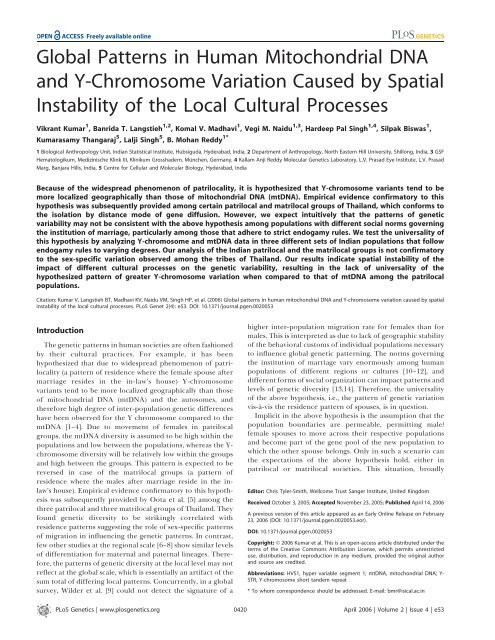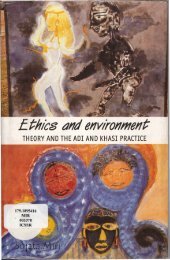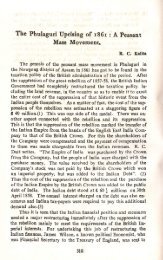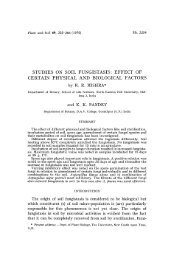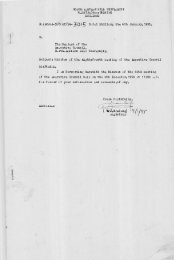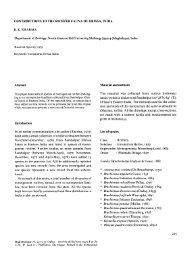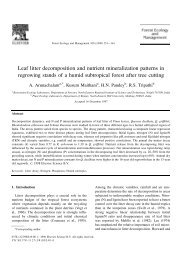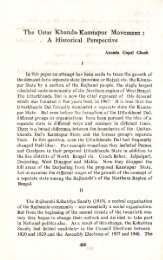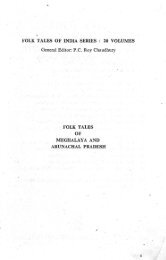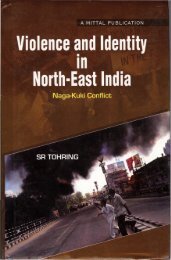ncbi - DSpace@NEHU: Home - North-Eastern Hill University, Shillong
ncbi - DSpace@NEHU: Home - North-Eastern Hill University, Shillong
ncbi - DSpace@NEHU: Home - North-Eastern Hill University, Shillong
Create successful ePaper yourself
Turn your PDF publications into a flip-book with our unique Google optimized e-Paper software.
Global Patterns in Human Mitochondrial DNA<br />
and Y-Chromosome Variation Caused by Spatial<br />
Instability of the Local Cultural Processes<br />
Vikrant Kumar 1 , Banrida T. Langstieh 1,2 , Komal V. Madhavi 1 , Vegi M. Naidu 1,3 , Hardeep Pal Singh 1,4 , Silpak Biswas 1 ,<br />
Kumarasamy Thangaraj 5 , Lalji Singh 5 , B. Mohan Reddy 1*<br />
1 Biological Anthropology Unit, Indian Statistical Institute, Hubsiguda, Hyderabad, India, 2 Department of Anthropology, <strong>North</strong> <strong>Eastern</strong> <strong>Hill</strong> <strong>University</strong>, <strong>Shillong</strong>, India, 3 GSF<br />
Hematologikum, Medizinische Klink III, Klinikum Grosshadern, München, Germany, 4 Kallam Anji Reddy Molecular Genetics Laboratory, L.V. Prasad Eye Institute, L.V. Prasad<br />
Marg, Banjara <strong>Hill</strong>s, India, 5 Centre for Cellular and Molecular Biology, Hyderabad, India<br />
Because of the widespread phenomenon of patrilocality, it is hypothesized that Y-chromosome variants tend to be<br />
more localized geographically than those of mitochondrial DNA (mtDNA). Empirical evidence confirmatory to this<br />
hypothesis was subsequently provided among certain patrilocal and matrilocal groups of Thailand, which conforms to<br />
the isolation by distance mode of gene diffusion. However, we expect intuitively that the patterns of genetic<br />
variability may not be consistent with the above hypothesis among populations with different social norms governing<br />
the institution of marriage, particularly among those that adhere to strict endogamy rules. We test the universality of<br />
this hypothesis by analyzing Y-chromosome and mtDNA data in three different sets of Indian populations that follow<br />
endogamy rules to varying degrees. Our analysis of the Indian patrilocal and the matrilocal groups is not confirmatory<br />
to the sex-specific variation observed among the tribes of Thailand. Our results indicate spatial instability of the<br />
impact of different cultural processes on the genetic variability, resulting in the lack of universality of the<br />
hypothesized pattern of greater Y-chromosome variation when compared to that of mtDNA among the patrilocal<br />
populations.<br />
Citation: Kumar V, Langstieh BT, Madhavi KV, Naidu VM, Singh HP, et al. (2006) Global patterns in human mitochondrial DNA and Y-chromosome variation caused by spatial<br />
instability of the local cultural processes. PLoS Genet 2(4): e53. DOI: 10.1371/journal.pgen.0020053<br />
Introduction<br />
The genetic patterns in human societies are often fashioned<br />
by their cultural practices. For example, it has been<br />
hypothesized that due to widespread phenomenon of patrilocality<br />
(a pattern of residence where the female spouse after<br />
marriage resides in the in-law’s house) Y-chromosome<br />
variants tend to be more localized geographically than those<br />
of mitochondrial DNA (mtDNA) and the autosomes, and<br />
therefore high degree of inter-population genetic differences<br />
have been observed for the Y chromosome compared to the<br />
mtDNA [1–4]. Due to movement of females in patrilocal<br />
groups, the mtDNA diversity is assumed to be high within the<br />
populations and low between the populations, whereas the Ychromosome<br />
diversity will be relatively low within the groups<br />
and high between the groups. This pattern is expected to be<br />
reversed in case of the matrilocal groups (a pattern of<br />
residence where the males after marriage reside in the inlaw’s<br />
house). Empirical evidence confirmatory to this hypothesis<br />
was subsequently provided by Oota et al. [5] among the<br />
three patrilocal and three matrilocal groups of Thailand. They<br />
found genetic diversity to be strikingly correlated with<br />
residence patterns suggesting the role of sex-specific patterns<br />
of migration in influencing the genetic patterns. In contrast,<br />
few other studies at the regional scale [6–8] show similar levels<br />
of differentiation for maternal and paternal lineages. Therefore,<br />
the patterns of genetic diversity at the local level may not<br />
reflect at the global scale, which is essentially an artifact of the<br />
sum total of differing local patterns. Concurrently, in a global<br />
survey, Wilder et al. [9] could not detect the signature of a<br />
higher inter-population migration rate for females than for<br />
males. This is interpreted as due to lack of geographic stability<br />
of the behavioral customs of individual populations necessary<br />
to influence global genetic patterning. The norms governing<br />
the institution of marriage vary enormously among human<br />
populations of different regions or cultures [10–12], and<br />
different forms of social organization can impact patterns and<br />
levels of genetic diversity [13,14]. Therefore, the universality<br />
of the above hypothesis, i.e., the pattern of genetic variation<br />
vis-à-vis the residence pattern of spouses, is in question.<br />
Implicit in the above hypothesis is the assumption that the<br />
population boundaries are permeable, permitting male/<br />
female spouses to move across their respective populations<br />
and become part of the gene pool of the new population to<br />
which the other spouse belongs. Only in such a scenario can<br />
the expectations of the above hypothesis hold, either in<br />
patrilocal or matrilocal societies. This situation, broadly<br />
Editor: Chris Tyler-Smith, Wellcome Trust Sanger Institute, United Kingdom<br />
Received October 3, 2005; Accepted November 23, 2005; Published April 14, 2006<br />
A previous version of this article appeared as an Early Online Release on February<br />
23, 2006 (DOI: 10.1371/journal.pgen.0020053.eor).<br />
DOI: 10.1371/journal.pgen.0020053<br />
Copyright: Ó 2006 Kumar et al. This is an open-access article distributed under the<br />
terms of the Creative Commons Attribution License, which permits unrestricted<br />
use, distribution, and reproduction in any medium, provided the original author<br />
and source are credited.<br />
Abbreviations: HVS1, hyper variable segment 1; mtDNA, mitochondrial DNA; Y-<br />
STR, Y-chromosome short tandem repeat<br />
* To whom correspondence should be addressed. E-mail: bmr@isical.ac.in<br />
PLoS Genetics | www.plosgenetics.org 0420<br />
April 2006 | Volume 2 | Issue 4 | e53
Synopsis<br />
In most human societies, women traditionally move to their<br />
husband’s home after marriage, and these societies are thus<br />
‘‘patrilocal,’’ but in a few ‘‘matrilocal’’ societies, men move to their<br />
wife’s home. These social customs are expected to influence the<br />
patterns of genetic variation. They should lead to a localization of<br />
male-specific Y-chromosomal variants and wide dispersal of femalespecific<br />
mitochondrial DNA variants in patrilocal societies and vice<br />
versa in matrilocal societies. These predicted patterns have indeed<br />
been observed in previous studies of populations from Thailand.<br />
Indian societies, however, are endogamous, so marriage should<br />
always take place within a population, and these different patterns<br />
of genetic variation should not build up. The authors have now<br />
analyzed ten patrilocal and five matrilocal Indian populations, and<br />
find that there is indeed little difference between the patrilocal and<br />
matrilocal societies. The authors therefore conclude that patterns of<br />
genetic variation in humans are not universal, but depend on local<br />
cultural practices.<br />
speaking, approximates to isolation by distance mode of gene<br />
diffusion. On the other hand, for populations bound by rigid<br />
endogamy rules with their boundaries absolutely impermeable,<br />
neither patrilocality nor matrilocality can make any<br />
difference to their genetic variability, be it Y-chromosome or<br />
mtDNA, since the movement is restricted to within a<br />
population. The Indian subcontinent with its unique population<br />
structure and strictly defined endogamous castes,<br />
tribes, and religious groups is a case in point (Figure 1). The<br />
marriage interactions are restricted within an endogamous<br />
population consisting of the number of exogamous units/<br />
clans between which marriages take place. We directly test<br />
the universality of the hypothesis delineated above and<br />
attempt to assess the spatial stability of the local cultural<br />
processes necessary to influence global patterning in two<br />
stages. In the first stage, we analyzed Y-chromosome short<br />
tandem repeat (Y-STR) and mtDNA hyper variable segment 1<br />
(HVS1) sequence data from two groups of Indian tribes,<br />
comprised of five populations each, belonging to a broad<br />
linguistic family and with similar socio-economic status. The<br />
genetic data were obtained from the same set of populations<br />
and individuals making it appropriate for comparison. The<br />
populations included in this study are Maram, Khynriam,<br />
Pnar, Bhoi, and WarKhasi, the five matrilocal Khasi tribes of<br />
Meghalaya in the <strong>North</strong>eastern part of India; and Asur,<br />
Bhumij, Kharia, Munda, and Santhal, the five patrilocal<br />
Mundari tribes of <strong>Eastern</strong> India, who along with the<br />
matrilocal Khasis, belong to the broad Austro-Asiatic<br />
linguistic family. At the second stage, to gauge the consistency<br />
in the genetic patterns within broad regional or cultural<br />
context, the same set of genetic data were generated on the<br />
five Dravidian language-speaking patrilocal caste populations<br />
from Andhra Pradesh (Akutota, Kapu, Panta, Pokanati, and<br />
Vanne) of Southern India and compared with the Austro-<br />
Asiatic matrilocal tribes.<br />
The structure of populations considered in this study is<br />
characterized by numerous endogamous groups cohabiting as<br />
islands with no or negligible gene flow between them.<br />
Therefore, as the marital boundary of each population is<br />
impermeable, we intuitively expect that the pattern of genetic<br />
variability may not strictly follow the expectations of the<br />
aforesaid hypothesis, either in patrilocal or matrilocal<br />
Genetic Variation and Culture<br />
Figure 1. Schematic Representation of Indian Population Structure<br />
Characterized by Movement of Spouses Only within but Not among the<br />
Endogamous Groups<br />
Each circle represents a population and its size represents the hierarchy.<br />
While the populations until the breeding isolates are all endogamous,<br />
the exogamous units refer to clans/lineages within a breeding isolate/<br />
population.<br />
DOI: 10.1371/journal.pgen.0020053.g001<br />
groups. All three groups of populations have contiguous<br />
geographic distribution in their respective areas, which<br />
provide opportunity for exchange of mates, if the social<br />
norms permit, thus providing ideal study frame.<br />
PLoS Genetics | www.plosgenetics.org 0421<br />
April 2006 | Volume 2 | Issue 4 | e53
Figure 2. Haplotype Diversity in mtDNA (Green) and Y-STR (Pink) and Their Mean (Shaded Bar) in Five Dravidian and Five Austro-Asiatic Patrilocal and<br />
Five Austro-Asiatic Matrilocal Populations<br />
From left to right, the Dravidian patrilocal groups (mtDNA sample size and Y-STR sample size) are Akhutota (32, 21), Kapu (22,16), Panta (37, 21),<br />
Pokanati (59, 25), and Vanne (32, 23); the Austro-Asiatic matrilocal groups are Maram (72, 58), Khynriam (95, 82), Pnar (69, 40), Bhoi (34, 30), and<br />
WarKhasi (31, 23); the Austro-Asiatic patrilocal groups are Asur (30, 28), Bhumij (40, 39), Kharia (21, 13), Munda (23, 23), and Santhal (39, 38).<br />
DOI: 10.1371/journal.pgen.0020053.g002<br />
Results<br />
Within-group mtDNA diversity (Figure 2) is similar (Mann-<br />
Whitney U test, p ¼ 0.690) for matrilocal Khasi tribes (0.975)<br />
versus patrilocal Mundari tribes (0.962), although the mean<br />
within-group Y-chromosome diversity of patrilocal Mundari<br />
tribal groups (0.954) is significantly lower (Mann-Whitney U<br />
test, p ¼ 0.008) when compared with matrilocal Khasi (0.995).<br />
However, when we compare the patrilocal Dravidian caste<br />
groups with the matrilocal Khasi tribes we found similar and<br />
non-significant difference in the level of within-group<br />
diversity for both mtDNA (p ¼ 0.056) and Y-chromosome (p<br />
¼ .095). The average values of genetic distance (Table 1)<br />
reflecting inter-group diversity (although smaller for mtDNA<br />
and larger for Y-chromosome among patrilocal Mundari<br />
groups than for matrilocal Khasi groups) are not statistically<br />
significantly different. Likewise, the average genetic distances<br />
in the Dravidian patrilocal groups are smaller for mtDNA and<br />
larger for Y-chromosome but not significantly so when<br />
compared with the matrilocal Khasi groups.<br />
The index of probability of identity, which gives a<br />
quantitative measure of haplotype sharing between a pair of<br />
populations, further suggests, as against the hypothesis, that<br />
the degree of Y-chromosome haplotype sharing (Table 2),<br />
although not significant, is substantially higher among the<br />
patrilocal Mundari groups when compared with the Matrilocal<br />
Khasi tribes, whereas the degree of mtDNA haplotype<br />
sharing is almost identical for both groups. On the other hand,<br />
we observe a very low level of mtDNA haplotype sharing<br />
among the patrilocal Dravidian groups compared with the<br />
matrilocal Khasi groups, while the level of Y-chromosome<br />
haplotype sharing is similar for both the groups. As per the<br />
hypothesis, a relatively lower degree of mtDNA haplotype<br />
sharing and greater degree of Y-chromosome haplotype<br />
sharing is expected among the matrilocal groups compared<br />
with the patrilocal groups. Overall, the results are not<br />
consistent with the universality of the hypothesis in question.<br />
Discussion<br />
The foregoing analysis of the results does not reflect higher<br />
migration rate of females and males, respectively, in the<br />
patrilocal and matrilocal populations, suggesting that the<br />
pattern of residence of the spouses has no bearing on the<br />
mtDNA and Y-chromosome variability in the populations, in<br />
which sex-specific migrations implicit in the hypothesis are<br />
Table 1. Average Genetic Distance and Their Standard Error Based on mtDNA HVS1 and Y-STR among the Matrilocal and Patrilocal<br />
Groups<br />
Genetic<br />
Distances<br />
Patrilocal<br />
(Austro-Asiatic; Mundari)<br />
Average 6 SE<br />
Matrilocal<br />
(Austro-Asiatic; Khasi)<br />
Average 6 SE<br />
Patrilocal<br />
(Dravidian)<br />
Average 6 SE<br />
Genetic Variation and Culture<br />
Mann-Whitney U Test<br />
(p: Two-Tailed a )<br />
Mundari<br />
versus Khasi<br />
R st (Y-STR) 0.100 6 0.002 0.055 6 0.001 0.114 6 0.003 0.123 0.474<br />
D A (mtDNA) 0.128 6 0.103 0.200 6 0.095 0.142 6 0.087 0.165 0.971<br />
Dravidian<br />
versus Khasi<br />
Genetic distances (dA and Rst) and SE, based on 1,000 bootstrap replicates, were calculated using MEGA (http://www.megasoftware.net/mega3/mega.html) and RSTCALC (http://helios.<br />
bto.ed.ac.uk/evolgen/rst/rst.html).<br />
a<br />
Calculated on the basis of genetic distance matrices.<br />
SE, standard error.<br />
DOI: 10.1371/journal.pgen.0020053.t001<br />
PLoS Genetics | www.plosgenetics.org 0422<br />
April 2006 | Volume 2 | Issue 4 | e53
Table 2. Index of Probability of Identity Based on mtDNA HVS1 and Y-STR among the Patrilocal and Matrilocal Groups<br />
Genetic<br />
Markers<br />
Patrilocal<br />
(Austro-Asiatic;<br />
Mundari) Average<br />
Matrilocal<br />
(Austro-Asiatic;<br />
Khasi) Average<br />
confined within the endogamous groups and do not usually<br />
transect the caste/tribal boundaries. However, a weak and nonsignificant<br />
trend of greater inter-group variation in Ychromosome<br />
and lower variation in mtDNA in case of<br />
patrilocal groups, and greater mtDNA and lower Y-chromosome<br />
inter-group variation in matrilocal groups, which is<br />
consistent with the hypothesis, is observed. Nevertheless, the<br />
magnitude of differences, either intra- or inter-population<br />
observed in our study, are substantially smaller than what has<br />
been observed by Oota et al. [5] in Thailand, despite a relatively<br />
small number of samples and populations. The non-significant<br />
differences in the mean values of the genetic distances could<br />
have been due to two reasons: (1) either to small sample size;<br />
hence lacking sufficient power to correctly reject the null<br />
hypothesis, or (2) to small number of Y-STRs, which may not<br />
have adequate resolution. Therefore, we calculated power of<br />
the Mann-Whitney U test for the given sample sizes in the<br />
study and the results suggest that the test has . 99% power,<br />
even at alpha ¼ 0.001, both for mtDNA and Y-chromosome.<br />
Additional analysis based on 15 Y-STRs suggests, contrary to<br />
the hypothesis, that the average genetic distance among the<br />
patrilocal groups was quite low (0.0469 6 0.0009), albeit nonsignificantly<br />
(p ¼ 0.1), as compared with the matrilocal groups<br />
(0.1024 6 0.0024). Therefore, the hypothesized correlation of<br />
genetic diversity with the sex-specific migration patterns may<br />
not be applicable to the Indian situation, although it is<br />
observed elsewhere in certain populations whose marital<br />
boundaries are probably permeable.<br />
One of the questions raised by Wilder et al. [9] is the extent<br />
to which local cultural practices influence genetic patterns at<br />
the regional and global scale. The groups we have considered<br />
in the present study have different cultural norms governing<br />
the rules of marriages compared to those studied by Oota et<br />
al. [5]; hence we find variation in the genetic patterns. Even<br />
within India, we find variation in the pattern depending on<br />
whether we compare the matrilocal Khasi tribes with the<br />
patrilocal Mundari tribal groups or with the patrilocal<br />
Dravidian caste groups. For example, the index of probability<br />
of identity shows very low values for both mtDNA and Ychromosome<br />
haplotype sharing among the Dravidian castes<br />
when compared with the Austro-Asiatic tribes, either<br />
Mundari or Khasi (Table 2). This pattern is observed because<br />
the caste populations of India are considered to follow<br />
endogamy very strictly; hence their marital boundaries are<br />
highly rigid compared with the marital boundaries of the<br />
Indian tribes, particularly from <strong>North</strong>east India, suggesting<br />
the impact of varying cultural practices pertaining partic-<br />
Patrilocal<br />
(Dravidian)<br />
Average<br />
ularly to marriage, resulting in variable genetic patterns.<br />
Results of our study taken together with the previous studies,<br />
that have [6–8] or have not [1,3–5] detected sex-specific<br />
migration, suggest that the local cultural processes do not<br />
have spatial stability required to influence global patterning.<br />
Perhaps due to this, Wilder et al. [9] did not observe higher<br />
migration rates of females vis-à-vis males at the continental<br />
level, although most of the populations of the world follow<br />
patrilocality [15]. Therefore, the hypothesis of greater Ychromosome<br />
vis-à-vis mtDNA variability due to patrilocality<br />
is not universal, as it can only be selectively applicable to<br />
populations with cultural norms that permit inter-group<br />
marriages; not to, for example, highly endogamous Indian<br />
populations. Pertinent to this are the two recent large-scale<br />
Indian studies [16,17] wherein the lack of spatial structure in<br />
the quantitative biological variables—anthropometry and<br />
dermatoglyphics— and traditional genetic markers was<br />
inferred to be consistent with population structure characterized<br />
by numerous endogamous groups cohabiting as<br />
islands with no or negligible gene flow between them; the<br />
monotonic decline in the spatial autocorrelation expected<br />
under the model of contiguous diffusion of genes is not<br />
evident in those data.<br />
Materials and Methods<br />
Mann-Whitney U Test<br />
(p: Two-Tailed)<br />
Mundari versus<br />
Khasi<br />
Y-STR 0.0116 0.0023 0.0011 0.260 0.029<br />
mtDNA 0.0132 0.0117 0.0031 0.626 0.045<br />
DOI: 10.1371/journal.pgen.0020053.t002<br />
Genetic Variation and Culture<br />
Dravidian versus<br />
Khasi<br />
Blood samples from 636 individuals belonging to 15 populations<br />
were obtained for the above populations during 2000–2003 with<br />
informed written consent; DNA was extracted. The names of the<br />
populations along with their sample size are given in Figure 2. We<br />
analyzed 350 base pairs of the HVS1 of the mtDNA control region<br />
corresponding to positions 16050–16400 and six Y-STR loci (DYS19,<br />
DYS389I, DYS389b, DYS390, DYS391, and DYS393). Allele length for<br />
DYS389b was obtained by subtracting the allele length of DYS389I<br />
from DYS389II. The HVS1 sequences have been submitted to<br />
GenBank and are also available from the authors, as are the Y-STR<br />
data. To measure within-group variability we estimated haplotype<br />
diversity [18] for the HVS1 sequences and Y-STR haplotypes (Table<br />
S1), and calculated dA distances [19] for the HVS1 sequences using the<br />
number of different sites model, and R ST for the Y-STR haplotypes<br />
[20] as measures of between-group diversity. Further, we computed<br />
an index of probability of identity [21], which gives a quantitative<br />
measure of haplotype sharing between a pair of populations. To<br />
ascertain, for the given sample sizes, that the test has enough power at<br />
alpha ¼ 0.05– 0.001, we computed power required for the Mann-<br />
Whitney U test. For this purpose, we decreased the sample sizes by<br />
15% and used this sample size to compute power required for a t-test.<br />
This rule is based on the lower bound for the asymptotic relative<br />
efficiency (ARE) of the Mann-Whitney U test versus the t-distribution,<br />
which is 0.864. This says that no matter what the distribution is, the<br />
ARE of the Mann-Whitney U test can never be worse than 0.864 for a<br />
reasonable broad class of probability distributions. Inverting that<br />
gives an increase in the sample size by a factor of 1.157, and therefore<br />
the sample sizes were reduced by 15% [22]. To increase the<br />
PLoS Genetics | www.plosgenetics.org 0423<br />
April 2006 | Volume 2 | Issue 4 | e53
esolution, in addition to the six Y-STRs, we typed nine more Y-STRs<br />
(DYS388, DYS426, DYS437, DYS438, DYS439, DYS447, DYS448,<br />
DYS460, and H4; Table S2) in three populations each of Mundari<br />
patrilocal groups (Bhumij, Munda, and Santhal) and Khasi matrilocal<br />
groups (Khynriam, Maram, and Pnar) and recomputed genetic<br />
distances based on 15 Y-STR loci.<br />
Supporting Information<br />
Table S1. Y-Chromosome Haplotypes Based on Six Y-STRs for 15<br />
Populations<br />
Found at DOI: 10.1371/journal.pgen.0020053.st001 (946 KB DOC).<br />
Table S2. Y-Chromosome Haplotypes Based on Nine Y-STRs for Six<br />
Populations<br />
Found at DOI: 10.1371/journal.pgen.0020053.st002 (387 KB DOC).<br />
Accession Numbers<br />
The GenBank (http://www.<strong>ncbi</strong>.nlm.nih.gov) accession numbers for<br />
the sequence discussed in this paper are HVS1 (AY72095–AY721592).<br />
References<br />
1. Salem AH, Badr FM, Gaballah MF, Paabo S (1996) The genetics of<br />
traditional living. Y-chromosomal and mitochondrial lineages in the Sinai<br />
Peninsula. Am J Hum Genet 59: 741–743.<br />
2. Seielstad MT, Minch E, Cavalli-Sforza LL (1998) Genetic evidence for a<br />
higher female migration rate in humans. Nat Genet 20: 278–280.<br />
3. Perez-Lezaun A, Calafell F, Comas D, Mateu E, Bosch E, et al. (1999) Sexspecific<br />
migration pattern in Central Asian populations, revealed by<br />
analysis of Y-chromosome short tandem repeats and mtDNA. Am J Hum<br />
Genet 65: 208–219.<br />
4. Oota H, Kitano T, Jin F, Yuasa I, Wang L, et al. (2002) Extreme mtDNA<br />
homogeneity in continental Asian populations. Am J Phys Anthrop 118:<br />
146–153.<br />
5. Oota H, Settheetham-Ishida W, Tiwawech D, Ishida T, Stoneking M (2001)<br />
Human mtDNA and Y-chromosome variation is correlated with matrilocal<br />
versus patrilocal residence. Nat Genet 29: 20–21.<br />
6. Mesa NR, Mondragon MC, Soto ID, Parra MV, Duque C, et al. (2000)<br />
Autosomal, mtDNA, and Y-chromosome diversity in Amerinds: Pre- and<br />
post-Columbian patterns of gene flow in South America. Am J Hum Genet<br />
67: 1277–1286.<br />
7. Al-Zahery N, Semino O, Benuzzi G, Magri C, Passarino G, et al. (2003) Ychromosome<br />
and mtDNA polymorphisms in Iraq, a crossroad of the early<br />
human dispersal and of post-Neolithic migrations. Mol Phylogenet Evol 28:<br />
458–472.<br />
8. Fuselli S, Tarazona-Santos E, Dupanloup I, Soto A, Luiselli D, et al. (2003)<br />
Mitochondrial DNA diversity in South America and the genetic history of<br />
Andean highlanders. Mol Biol Evol 20: 1682–1691.<br />
9. Wilder JA, Kingan SB, Mobasher Z, Pilkington MM, Hammer MF (2004)<br />
Global patterns of human mitochondrial DNA and Y-chromosome<br />
structure are not influenced by higher migration rates of females versus<br />
males. Nat Genet 36: 1122–1125.<br />
Acknowledgments<br />
Genetic Variation and Culture<br />
This work is essentially a part of three different plan projects of the<br />
Indian Statistical Institute (ISI), Kolkata being carried out by BMR in<br />
collaboration with Centre for Cellular and Molecular Biology<br />
(CCMB), Hyderabad, India. Thanks are due to Directors of both the<br />
ISI and CCMB for logistic support. We are grateful to a large number<br />
of anonymous subjects from different parts of India who volunteered<br />
to give blood samples. We are also grateful to the anonymous<br />
reviewers whose comments helped in improved presentation of the<br />
results, and to T. Krishnan, former Professor of the ISI, for statistical<br />
advice in computing power of the Mann-Whitney U test.<br />
Author contributions. BMR conceived and designed the experiments.<br />
VK, BTL, KVM, VMN, HPS, and SB performed the experiments.<br />
VK and BMR analyzed the data. KT, LS, and BMR contributed<br />
reagents/materials/analysis tools. VK, BTL, and BMR collected<br />
samples. KT and LS commented on the draft of the manuscript. KT<br />
helped in preparing the diagrams. VK and BMR wrote the paper.<br />
Funding. This work was funded by the Indian Statistical Institute.<br />
Competing interests. The authors have declared that no competing<br />
interests exist. &<br />
10. Levinson D (1996) Encyclopedia of world cultures. New York: MacMillan.<br />
3855 p.<br />
11. Korotayev AV (2003) Form of marriage, sexual division of labor, and<br />
postmarital residence in cross-cultural perspective: A reconsideration. J<br />
Anthropol Res 59: 69–89.<br />
12. Marlowe FW (2004) Marital residence among foragers. Curr Anthropol 45:<br />
277–284.<br />
13. Austerlitz F, Heyer E (1998) Social transmission of reproductive behavior<br />
increases frequency of inherited disorders in a young-expanding population.<br />
Proc Natl Acad Sci U S A 95: 15140–15144.<br />
14. Excoffier L, Schneider S (1999) Why hunter-gatherer populations do not<br />
show signs of Pleistocene demographic expansions. Proc Natl Acad Sci U S<br />
A 96: 10597–10602.<br />
15. Burton ML, Moore CC, Whiting JWM, Romney AK (1996) Regions based on<br />
social structure. Curr Anthropol 37: 87–123.<br />
16. Reddy BM, Demarchi DA, Malhotra KC (2001) Patterns of variation in a<br />
caste-cluster of Dhangars of Maharashtra, India. Coll Antropol 25: 425–442.<br />
17. Reddy BM, Demarchi DA, Bharati S, Kumar V, Crawford MH (2004)<br />
Patterns of ethnic, linguistic, and geographic heterogeneity of palmar<br />
interdigital ridge counts in the Indian subcontinent. Hum Biol 76: 211–228.<br />
18. Nei M, Tajima F, Tateno Y (1983) Accuracy of estimated phylogenetic trees<br />
from molecular data. J Mol Evol 19: 153–170.<br />
19. Nei M (1987) Molecular evolutionary genetics. New York: Columbia<br />
<strong>University</strong> Press. 333 p.<br />
20. Slatkin M (1995) A measure of population subdivision based on microsatellite<br />
allele frequencies. Genetics 139: 457–462.<br />
21. Melton T, Peterson R, Redd AJ, Saha N, Sofro AS, et al. (1995) Polynesian<br />
genetic affinities with Southeast Asian populations as identified by mtDNA<br />
analysis. Am J Hum Genet 57: 403–414.<br />
22. Lehmann EL (1975) Nonparametrics: Statistical methods based on ranks.<br />
San Francisco: Holden-Day. 457 p.<br />
PLoS Genetics | www.plosgenetics.org 0424<br />
April 2006 | Volume 2 | Issue 4 | e53


